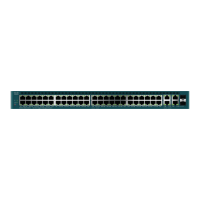IP Configuration: RIPv2
Configuring RIP
Cisco 500 Series Stackable Managed Switch Administration Guide Release 1.3 348
18
STEP 3 Redistribute Static Route—Select to enable this feature (described in
Redistribution Feature.
STEP 4 If Redistribute Static Route is enabled, select an option for the Redistribute
Static Metric field. The following options are available:
• Default Metric—Causes RIP to use the default metric value for the
propagated static route configuration (refer to Redistribution Feature).
• Transparent—Causes RIP to use the routing table metric as the RIP metric for
the propagated static route configuration. This results in the following
behavior:
- If the metric value of a static route is equal to or less than 15, this value is
used in the RIP protocol when advertising this static route.
- If the metric value of a static route is greater than 15, the static route is not
advertised to other routers using RIP.
• User Defined Metric—Enter the value of the metric.
STEP 5 Redistribute Connected Route—Select to enable this feature (described in
Redistributing Static Route Configuration.
STEP 6 If Redistribute Connected Route is enabled, select an option for the Redistribute
Static Metric field. The following options are available:
• Default Metric—Causes RIP to use the default metric value for the
propagated static route configuration (refer to Redistribution Feature).
• Transparent—Causes RIP to use the routing table metric as the RIP metric for
the propagated static route configuration. This results in the following
behavior:
- If the metric value of a static route is equal to or less than 15, this value is
used in the RIP protocol when advertising this static route.
- If the metric value of a static route is greater than 15, the static route is not
advertised to other routers using RIP.
• User Defined Metric—Enter the value of the metric.
STEP 7 Click Apply. The settings are written to the Running Configuration file.

